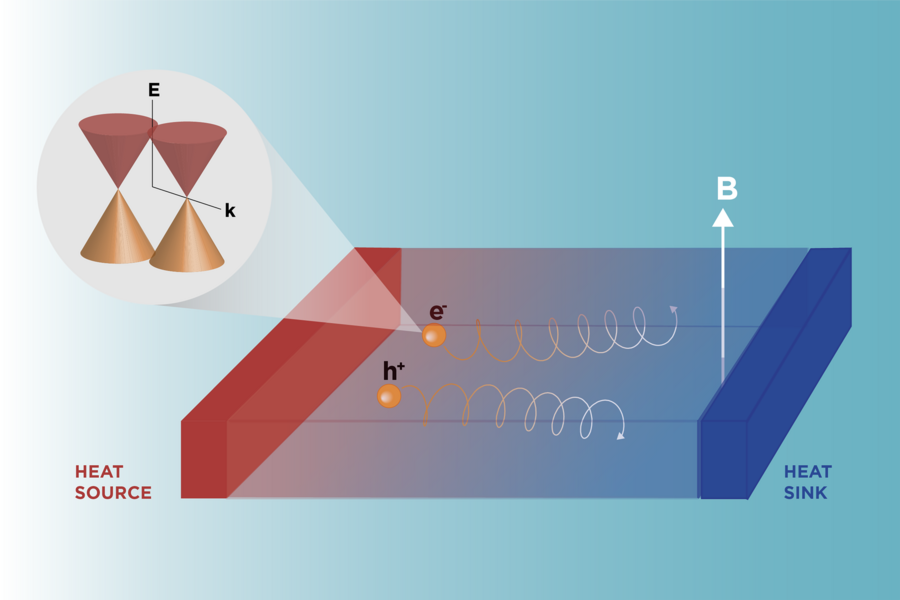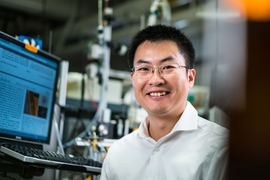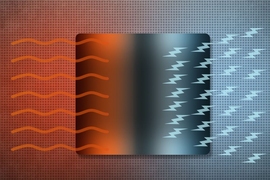More than two-thirds of the energy used worldwide is ultimately ejected as “waste heat.” Within that reservoir of discarded energy lies a great and largely untapped opportunity, claim scientists in MIT’s Department of Nuclear Science and Engineering (NSE). As reported in a recent issue of Nature Communications, the MIT team — led by Assistant Professor Mingda Li, who heads NSE’s Quantum Matter Group — has achieved a breakthrough in thermoelectric generation, which offers a direct means of converting thermal energy, including waste heat, into electricity.
A temperature gradient, or difference, within a material such as a metal or semiconductor can, through a phenomenon known as the Seebeck effect, give rise to an electrical voltage that drives a current. “For many materials, the thermoelectric effect is too low to be useful,” explains NSE Research Scientist Fei Han. “Our goal is to find materials with conversion efficiencies high enough to make thermoelectric generation more practical.”
The efficiency of thermoelectric energy conversion is proportional to a material’s temperature, electrical conductivity, and something called the “thermopower” squared; it is inversely proportional to the thermal conductivity. Because efficiency goes up with temperature, most thermoelectric materials used today operate in the range of hundreds of degrees centigrade. “But in our lives, most of the stuff around us is at room temperature,” Han says. “That’s why we’re trying to discover new materials that work effectively at or below room temperature.”
When it comes to conversion efficiencies, Li notes, “most attention has been devoted to increasing electrical conductivity and decreasing thermal conductivity, rather than focusing on thermopower, even though efficiency goes up with the square of thermopower.” Also known as the Seebeck coefficient, thermopower is defined as the voltage divided by the temperature difference across a material. “When thermopower goes up, electrical conductivity goes down, which can make for a tricky balancing act,” says Li. But his group has shown that a new mechanism can optimize both electrical conductivity and thermopower, thereby contributing to the goal of enhanced efficiency.
Li’s experimental research has been guided by theoretical papers published by Liang Fu, MIT associate professor of physics, and his former postdoc Brian Skinner and former PhD student Vladsyslav Kozii — all of whom contributed to the Nature Communications paper as well. In that earlier work, Fu and his colleagues argued that a strong magnetic field would boost the thermoelectric effect in a so-called topological Weyl semimetal.
This type of material shares characteristics of metals and semiconductors but has special features, too. Topological Weyl semimetals have singular points — like the hair whorls (or cowlicks) found on top of the scalp — that confer unusual electronic properties; other properties stem from symmetries of the crystalline structure itself. The gain in thermopower predicted by Fu and his colleagues would arise from the novel “thermoelectric quantum Hall effect.”
“When the magnetic field is high enough to elicit this effect,” explains NSE PhD student Nina Andrejevic, “a universal value of thermoelectric Hall conductivity is approached, and even if the magnetic field is varied, the value of the Hall conductivity will not change after that.” This induced thermoelectric Hall conductivity, she adds, “would be the dominant contributor to thermopower, as well as the dominant contributor to the total power factor.”
Li and his team prepared samples of a topological Weyl semimetal, tantalum phosphide (TaP), which were endowed with fine-tuned properties, in order to test Fu’s hypothesis. Synthesizing these TaP crystals was a difficult task, comments NSE graduate student Thanh Nguyen, “involving some trial-and-error because it’s such a new material [only known since 2015] that the recipes aren’t fully optimized yet. You can tinker with the relative amounts of tantalum and phosphide and adjust the oven temperature, as well as the time you ‘bake’ the ingredients, to meet the requisite level of charge carrier density. The crystal size also has to be large enough to facilitate high-precision measurements.” At the end of that process, they took the resultant TaP crystal — trimmed down to a thin strip — heated one end of it and, under the influence of a 9-tesla magnetic field, measured the electrical and thermal conductivity and the induced voltage.
The study yielded several significant, though related, results: The MIT researchers were the first to demonstrate that the thermoelectric quantum Hall effect could indeed be evoked in a Weyl semimetal. Owing to that effect, moreover, they obtained a very high value for the thermopower. In addition, their TaP crystal achieved a record high “power factor” — the product of electrical conductivity and thermopower squared — which is a crucial component of thermoelectric conversion efficiency.
“This is a significant accomplishment that may well lead to new applications for topological materials,” asserts Stony Brook University physicist Qiang Li, who also leads the Advanced Energy Materials Group at Brookhaven National Laboratory.
The power factor attained by the MIT group was 10 times bigger than had been observed in any other thermoelectric material, but that value was reached at 40 kelvins — a relatively frigid temperature that kept the group from breaking records in overall efficiency. The challenge now is to find a Weyl semimetal that can realize its peak power factor, and peak efficiency, closer to room temperature, Li says. “Although no such material has yet been uncovered, our latest work identifies several key properties we should be looking for.” Another goal is to develop a semimetal that can generate its own magnetic field, thanks to the introduction of magnetic elements into its crystalline structure, thereby eliminating the need for an external field.
With advent of new thermoelectric materials that can operate efficiently at or below room temperature, notes Andrejevic, “we might someday take advantage of energy sources that no one even considered before.”
The research, conducted in collaboration with Oak Ridge National Laboratory and Argonne National Laboratory, was funded through a grant from the U.S. Department of Energy Office of Science.










